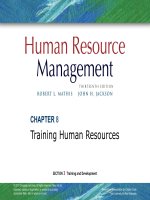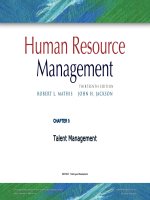Human resrouce management 12th mathis jacson chapter 0014
Bạn đang xem bản rút gọn của tài liệu. Xem và tải ngay bản đầy đủ của tài liệu tại đây (1.76 MB, 34 trang )
CHAPTER 14
Managing Employee Benefits
S E C T I O N 4 Compensating Human Resources
© 2008 Thomson/South-Western All rights reserved.
PowerPoint Presentation by Charlie Cook
The University of West Alabama
Chapter
Chapter Objectives
Objectives
After you have read this chapter, you should be able to:
■ Define a benefit and identify four strategic benefits considerations.
■ Summarize why benefits management and communications efforts
are important.
■ Distinguish between mandated and voluntary benefits and list
three examples of each.
■ Explain the importance of managing the costs of health benefits
and identify some methods of doing so.
■ Discuss the shift of retirement plans from defined-benefit to
defined-contribution and cash balance programs.
■ Describe the growth of financial, family-oriented, and time-off
benefits and their importance to many employees.
© 2008 Thomson/SouthWestern. All rights reserved.
14–2
Benefits and HR Strategy
• Benefit
An indirect reward given to an employee or group of
employees for organizational membership
EmployerProvided
Benefits
Absorb social
costs for health
care and
retirement
Influence
employee
decisions about
employers
© 2008 Thomson/SouthWestern. All rights reserved.
Are increasingly
seen as
entitlements
Average over
40% of total
payroll costs
14–3
FIGURE 14-1
Employer Compensation and Benefits Costs per Hour, Private Industry
© 2008 Thomson/SouthWestern. All rights reserved.
Source: U.S. Bureau of Labor Statistics, “Employer Costs for
Compensation,” News Release, June 21, 2006, www.bls.gov.
14–4
FIGURE 14-2
Strategic
Benefits
Considerations
© 2008 Thomson/SouthWestern. All rights reserved.
14–5
FIGURE 14-3
Benefits
Management
Components
© 2008 Thomson/SouthWestern. All rights reserved.
14–6
Benefits Design
• Decisions Affecting Benefit Design:
How much total compensation?
What part of total compensation should benefits
comprise?
What expense levels are acceptable for each benefit?
Which employees should get which benefits?
What are we getting in return for the benefit?
How will offering benefits affect turnover, recruiting,
and retention of employees?
How flexible should the benefits package be?
© 2008 Thomson/SouthWestern. All rights reserved.
14–7
FIGURE 14-4
Typical Division of HR Responsibilities: Benefits Administration
© 2008 Thomson/SouthWestern. All rights reserved.
14–8
HR and Benefits Administration
Benefits Administration Issues
and Trends
Outsourcing of
Benefits
Administration
Internet-Based
Administration
Systems
© 2008 Thomson/SouthWestern. All rights reserved.
Benefits
Measurement
(Return vs. Costs)
14–9
FIGURE 14-5
Common Benefits Metrics
• Benefits as a percentage of payroll (pattern over a
multi-year period)
• Benefits expenditures per full-time equivalent (FTE)
employee
• Benefits costs by employee group (full-time vs. parttime, union vs. nonunion, office, management,
professional, technical, etc.)
• Benefits administration costs (including staff time
multiplied by the staff pay and benefits costs per hour)
• Health-care benefits costs per participating employee
© 2008 Thomson/SouthWestern. All rights reserved.
14–10
FIGURE 14-6
How the Typical Benefits Dollar Is Spent
© 2008 Thomson/SouthWestern. All rights reserved.
Source: Based on data summarized from the U.S. Department of Labor, Bureau of Labor statistics, National Compensation Survey: Employee Benefits
in Private Industry in the United States, 2006; and Employee Benefits Study, 2006 ed. (Washington, D.C.: U.S. Chamber of Commerce, 2007).
14–11
FIGURE 14-7
Types of Mandated and Voluntary Benefits
© 2008 Thomson/SouthWestern. All rights reserved.
14–12
Security Benefits
Types of Security Benefits
Workers’
Compensation
Unemployment
Compensation
© 2008 Thomson/SouthWestern. All rights reserved.
Severance
Pay
14–13
FIGURE 14-8
Private Industry Workers with Health Benefits
© 2008 Thomson/SouthWestern. All rights reserved.
Source: U.S. Bureau of Labor Statistics, March 2006, www.bls.gov/ncs/home.htm.
14–14
Health-Care Benefits
Controlling Health-Care
Benefits Costs
Co-Payments
and Employee
Contributions
Managed Care
(PPOs and HMOs,
Utilization Reviews)
© 2008 Thomson/SouthWestern. All rights reserved.
Mini-Medical
Plans
14–15
Consumer-Driven Health (CDH) Plans
Employee-Focused Health
Benefits Plans
DefinedContribution
Health Plans
Health Savings
Accounts
(HSAs)
© 2008 Thomson/SouthWestern. All rights reserved.
Health
Reimbursement
Arrangement (HRA)
14–16
FIGURE 14-9
Components of Consumer-Driven Health Plans
© 2008 Thomson/SouthWestern. All rights reserved.
14–17
FIGURE 14-10
Overview of Consolidated Omnibus Budget Reconciliation Act
(COBRA) Provisions
© 2008 Thomson/SouthWestern. All rights reserved.
14–18
Health-Care Legislation
• Health Insurance Portability and Accountability
Act (HIPAA) of 1996
Allows employees to switch their health insurance
plan from one company to another, regardless of preexisting health conditions.
Requires employers to provide privacy notices to
employees and to not disclose of health information
without authorization.
• Flexible Spending Accounts
Benefits plans that allow employees to contribute pre-
tax dollars to fund certain additional benefits.
© 2008 Thomson/SouthWestern. All rights reserved.
14–19
Retirement Benefits
• Social Security Act of 1935
Provides old age, survivor’s, disability,
and retirement benefits.
Federal
payroll tax (7.65%) on both
the employer and the employee.
Medicare
taxes are 2.9%.
Benefit
payments are based on
an employee’s lifetime earnings.
Administered by the Social
Security Administration.
© 2008 Thomson/SouthWestern. All rights reserved.
14–20
FIGURE 14-11
Median Age at Retirement by Gender
© 2008 Thomson/SouthWestern. All rights reserved.
Source: U.S. Bureau of Labor Statistics, www.bls.gov.
14–21
Pension Plans
Types of Pension Plans
DefinedBenefit Plan
DefinedContribution Plan
© 2008 Thomson/SouthWestern. All rights reserved.
Cash
Balance Plan
14–22
FIGURE 14-12
Worker
Participation in
Pension Plans
© 2008 Thomson/SouthWestern. All rights reserved.
14–23
Pension Plan Concepts
Contributory
Plan
Non-Contributory
Plan
Pension
Plan
Formats
Vesting of
Pension Rights
© 2008 Thomson/SouthWestern. All rights reserved.
Portability of
Pension Benefits
14–24
Individual Retirement Options
Individual Retirement
Account (IRA)
401(k) and Roth IRA
Individual
Retirement
Options
403(b)
Keogh
© 2008 Thomson/SouthWestern. All rights reserved.
14–25









